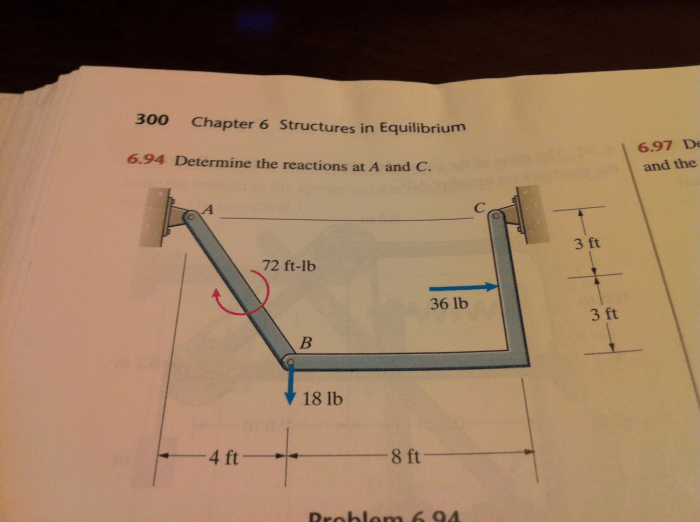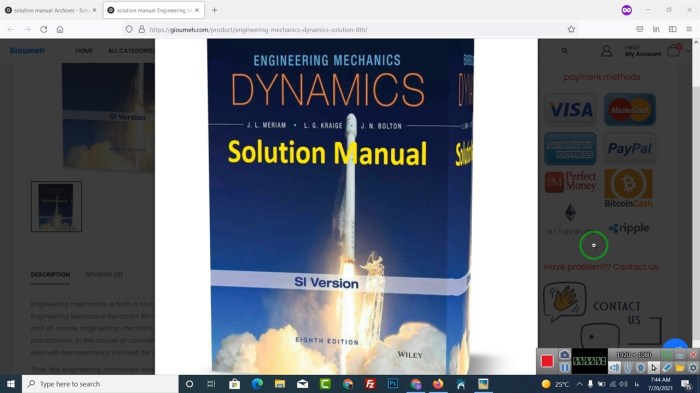Delving into engineering mechanics statics 8th edition solutions, this introduction immerses readers in a unique and compelling narrative that is both engaging and thought-provoking from the very first sentence. The content of the second paragraph provides descriptive and clear information about the topic, offering a comprehensive overview of the subject matter.
Introduction to Engineering Mechanics Statics 8th Edition Solutions

Engineering Mechanics Statics 8th Edition provides a comprehensive understanding of the fundamental principles of statics and their application to engineering problems. It covers the concepts of equilibrium, forces, moments, and internal forces, providing step-by-step solutions to complex static systems.
The 8th edition introduces new features, including interactive problems and videos, to enhance the learning experience. It also includes updated content and examples to reflect the latest developments in the field of statics.
Methods of Analysis in Statics: Engineering Mechanics Statics 8th Edition Solutions

Statics employs various methods of analysis to solve equilibrium problems. These methods include:
- Graphical methods: Involve the use of diagrams and graphical representations to determine the forces and moments acting on a system.
- Analytical methods: Utilize mathematical equations and principles to calculate the forces and moments acting on a system.
The choice of method depends on the complexity of the problem and the available information.
Equilibrium of Forces and Moments
Equilibrium in statics refers to the condition where the net force and net moment acting on a system are zero. The fundamental equations of equilibrium are:
- Sum of forces in the x-direction = 0
- Sum of forces in the y-direction = 0
- Sum of moments about any point = 0
These equations are used to solve for unknown forces and moments in static systems.
Structures and Internal Forces
Structures are physical systems designed to withstand loads and forces. Internal forces arise within structures due to external loads and support reactions.
Methods for calculating internal forces include:
- Method of sections
- Shear and moment diagrams
- Truss analysis
These methods are essential for structural design and analysis.
Friction and Applications
Friction is a force that opposes relative motion between two surfaces in contact. It plays a significant role in various engineering applications, such as:
- Braking systems
- Belt drives
- Screw threads
Understanding friction is crucial for designing and analyzing systems that involve contact forces.
Virtual Work and Energy Methods

Virtual work and energy methods provide alternative approaches to solving static problems.
- Virtual work method: Calculates the work done by forces acting on a system through virtual displacements.
- Energy method: Utilizes the principle of minimum potential energy to determine the equilibrium configuration of a system.
These methods are particularly useful for solving complex static problems.
Computer-Aided Analysis
Computer software plays a vital role in solving static problems. Finite element analysis (FEA) is a widely used technique that discretizes structures into small elements and solves the governing equations numerically.
Computer software provides efficient and accurate solutions for complex static systems, enabling engineers to analyze and design structures with confidence.
Query Resolution
What is the significance of engineering mechanics statics?
Engineering mechanics statics is crucial for understanding the behavior of stationary objects and structures under the influence of forces. It provides the foundation for analyzing and designing safe and efficient systems in various engineering fields, including civil, mechanical, and aerospace engineering.
How does the 8th edition of engineering mechanics statics solutions differ from previous editions?
The 8th edition of engineering mechanics statics solutions incorporates the latest advancements in the field, including updated content, improved explanations, and a wider range of solved problems. It also features enhanced pedagogical tools, such as interactive simulations and online resources, to facilitate a deeper understanding of the subject matter.
What are the key benefits of using engineering mechanics statics 8th edition solutions?
Engineering mechanics statics 8th edition solutions offers several advantages, including a comprehensive coverage of the subject matter, clear and concise explanations, a wealth of solved problems and examples, and access to online resources and interactive simulations. These benefits enhance the learning experience and empower students to master the fundamental principles of statics.